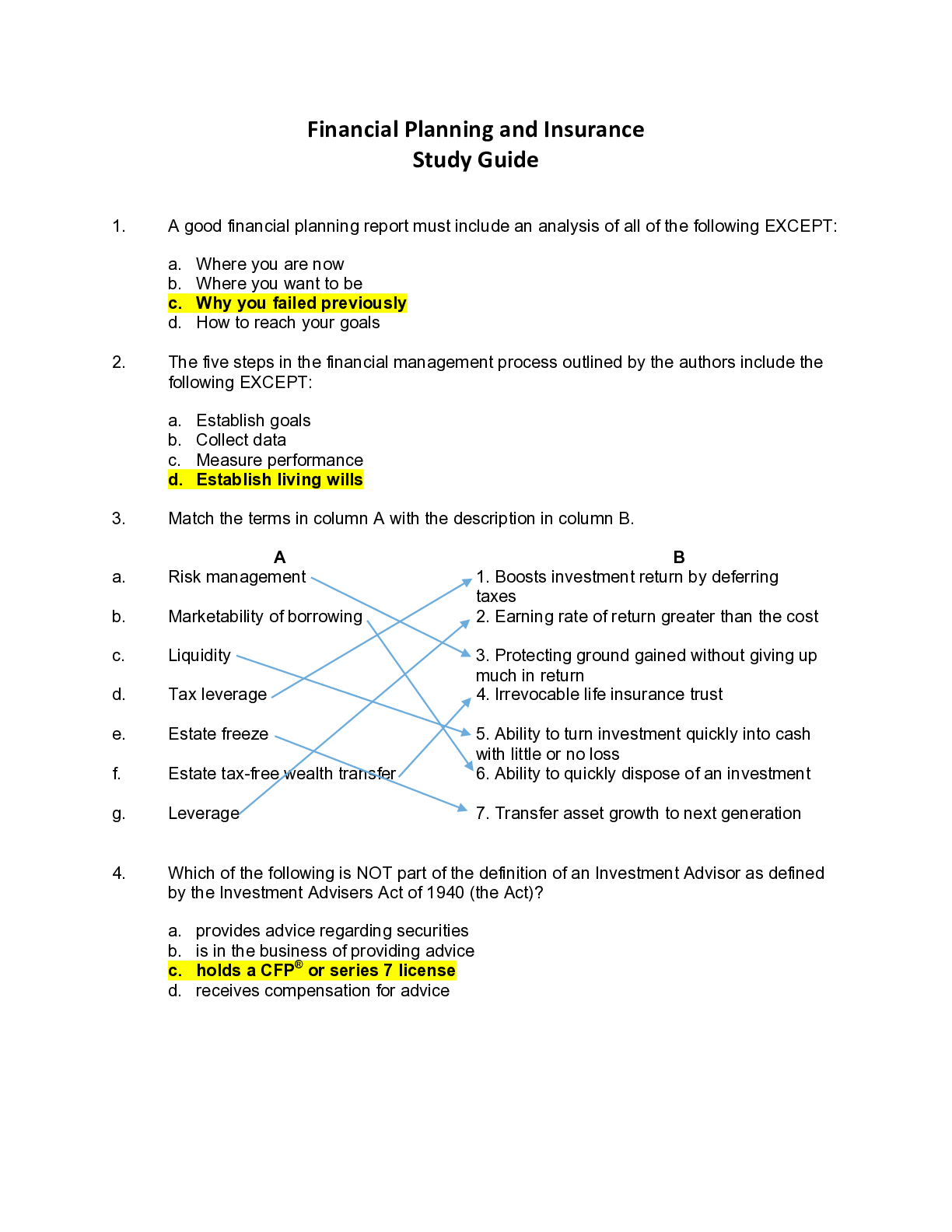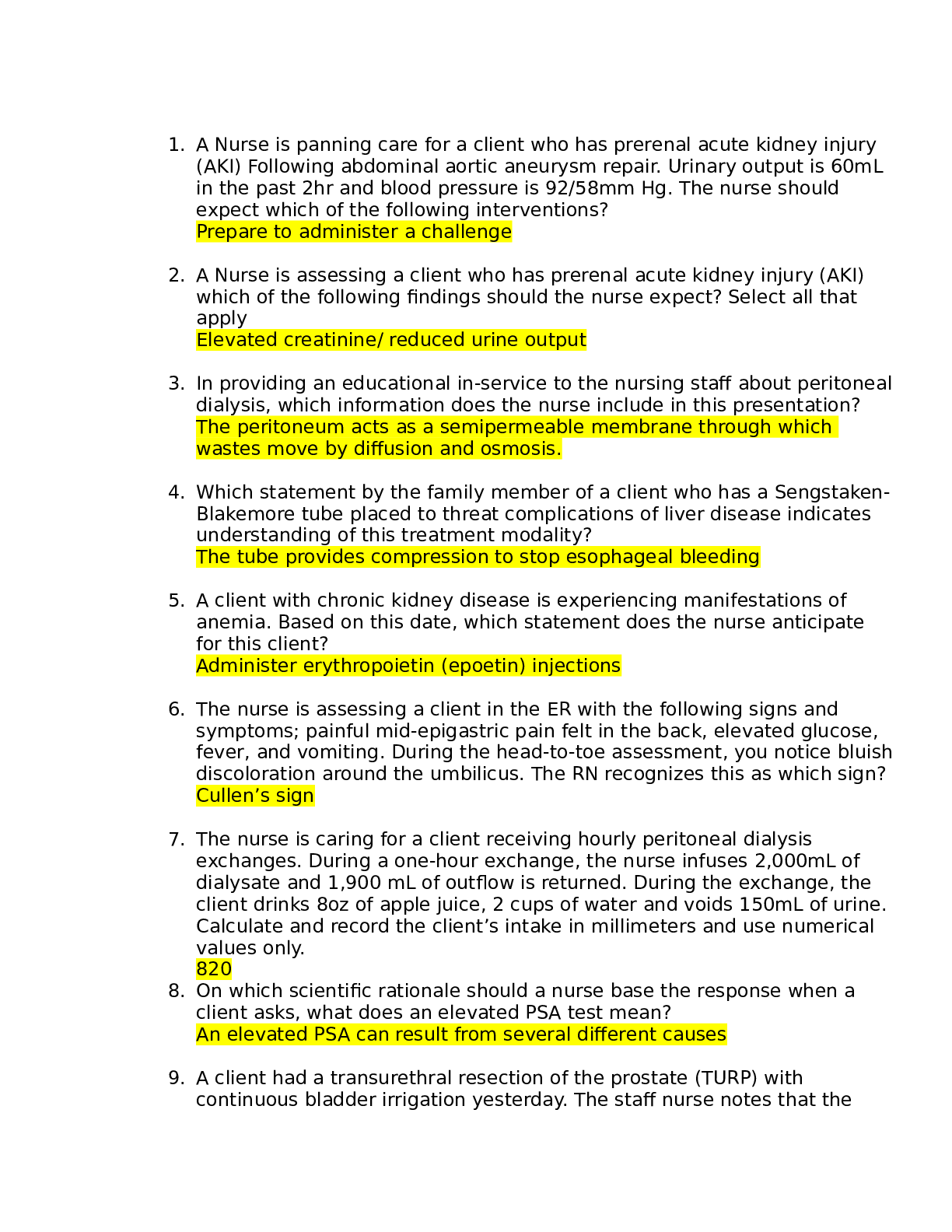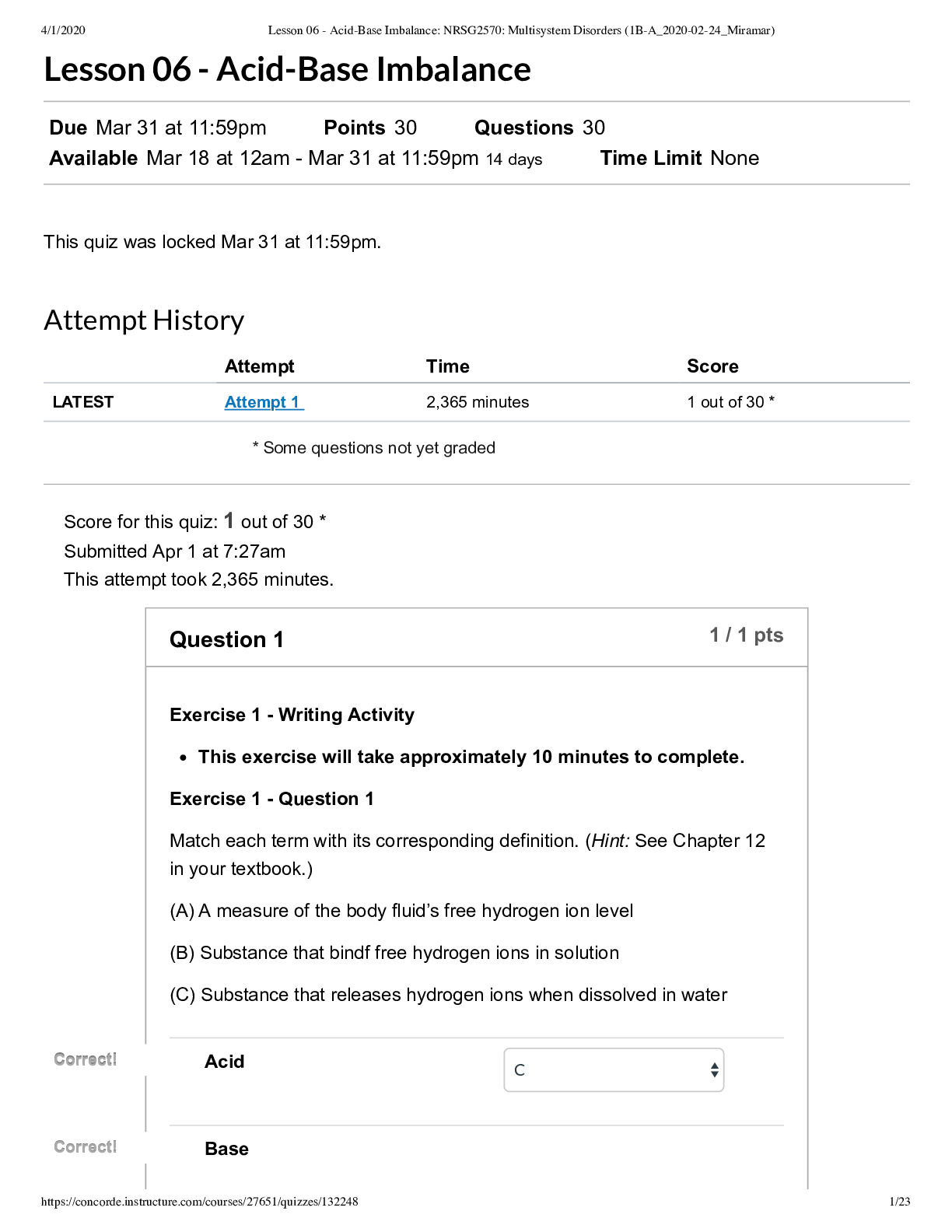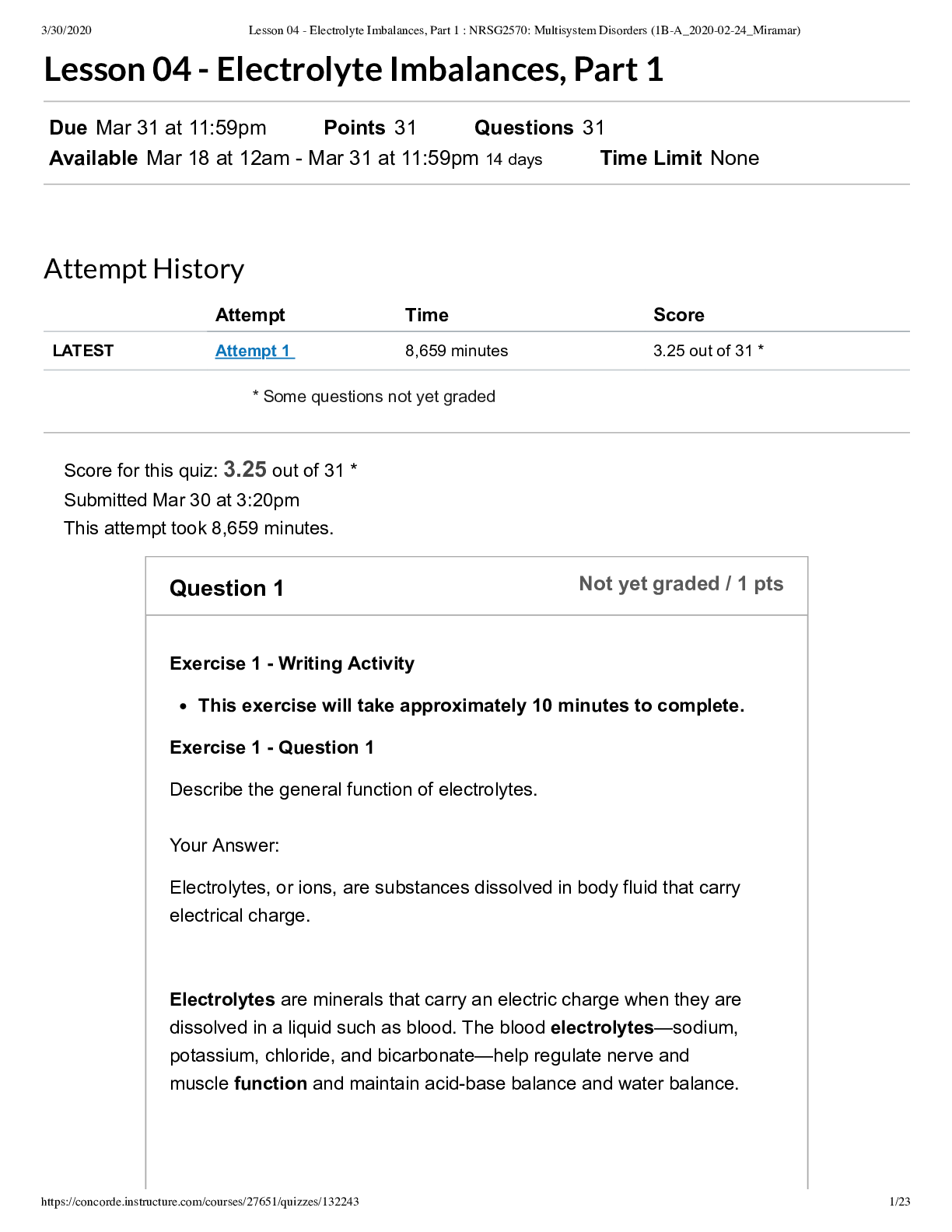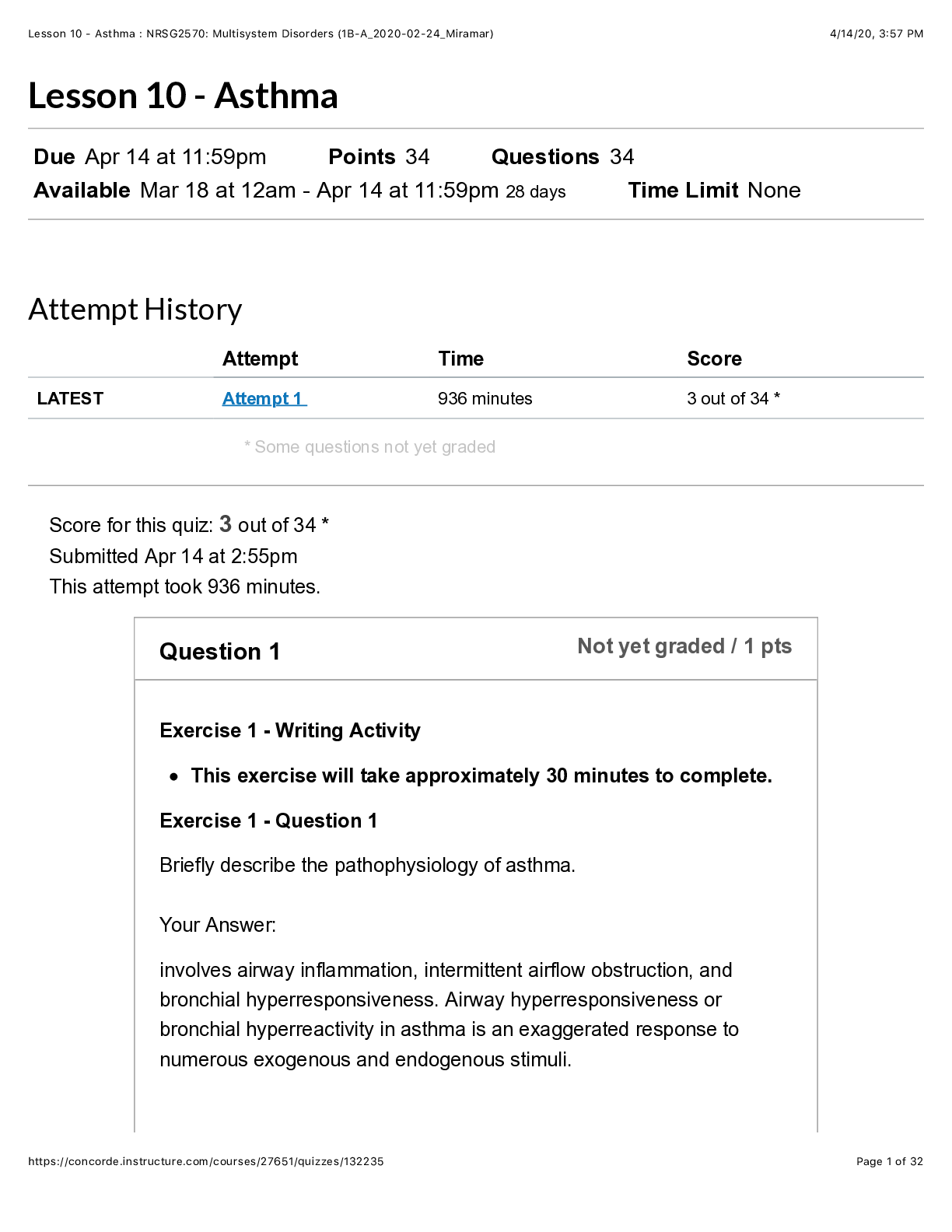*NURSING > QUESTIONS & ANSWERS > Miami Dade College, Miami NUR 2212 Bioterrorism (All)
Miami Dade College, Miami NUR 2212 Bioterrorism
Document Content and Description Below
Bioterrorism A client is admitted with dysphasia, dry mouth, drooping eyelids, blurred vision, vomiting, and diarrhea, and within 24 hours develops bilateral cranial nerve impairment and descending... weakness. Which bioterrorism agent results in these clinical manifestations? 1 Plague 2 Anthrax Correct3 Botulism 4 Smallpox These symptoms are found with botulism. With anthrax and smallpox, a rash will be noted. Symptoms of lymphatic plague include fever and chills, painful lymphadenopathy, gastrointestinal symptoms, and progressive weakness. 57%of students nationwide answered this question correctly. View Topics 1 3214374219 Confidence: Pretty sure Stats Issue with this question? 4. o Chart/Exhibit 1The nurse is planning to triage clients after a disaster. Which client does the nurse categorize into the green-tagged category? 1 Client A 2 Client B 3 Client C Correct4 Client D The disaster triage tag system categorizes triage priority by color. Clients with minor injuries that can be managed in a delayed fashion are categorized as greentagged. Therefore client D with bruises and lacerations on the skin is greentagged. Client A, with the lifethreatening condition of an airway obstruction is redtagged. Client B with large wounds and open fractures needs treatment within 30 minutes to 2 hours and is yellowtagged. Client C with critical massive head trauma is blacktagged. TestTaking Tip: Chart/exhibit items present a situation and ask a question. A variety of objective and subjective information is presented about the client in formats such as the medical record (e.g., laboratory test results, results of diagnostic procedures, progress notes, healthcare provider orders, medicationadministration record, health history), physical assessment data, and assistant/client interactions. After analyzing the information presented, the test taker answers the question. These questions usually reflect the analyzing level of cognitive thinking. In a clinical exam, you may be expected to select instruments, arrange instruments, and/or perform some other task. Acquaint yourself with the physical facility. If the required procedures are not clear to you, ask for clarification. 86%of students nationwide answered this question correctly. View Topics 1 3204912760 Confidence: Pretty sure Stats Issue with this question? 6. Which tag color according to the disaster triage tag system is assigned to a client who has an immediate threat to life? Correct1 Red tag 2 Black tag 3 Green tag 4 Yellow tag According to the disaster triage tag system, a red colored tag is used for a client who has an immediate threat to life. A black colored tag is used for a client who is expected to die or is dead. Green colored tags are used for a client who has minor injuries. A yellow colored tag is used for a client who has major injuries and is requiring immediate treatment. 92%of students nationwide answered this question correctly. View Topics 1 3204912741 Confidence: Pretty sure Stats Issue with this question? 7. o Chart/Exhibit 1The nurse is assessing four clients in the hospital. Which client should the nurse categorize in an emergent level according to the three-tiered triage system? Correct1 Client A 2 Client B 3 Client C 4 Client D The threetiered triage system classifies clients into three levels based on their conditions. The emergent level includes those clients who are in a lifethreatening condition and need immediate treatment. Client A has respiratory distress, which is a lifethreatening condition and is, therefore, categorized in the emergent level. The urgent level includes those clients that need quick treatment but do not have lifethreatening complications. Client B has multiple fractures, which are not lifethreatening but need quick treatment and is, therefore, categorized an urgent level. Client C has sprains and strains, which do not require immediate treatment, and the client is categorized in the nonurgent level. Client D has a cold, which does not require immediate treatment and is categorized in a nonurgent level.TestTaking Tip: Chart/exhibit items present a situation and ask a question. A variety of objective and subjective information is presented about the client in formats such as the medical record (e.g., laboratory test results, results of diagnostic procedures, progress notes, healthcare provider orders, medication administration record, health history), physical assessment data, and assistant/client interactions. After analyzing the information presented, the test taker answers the question. These questions usually reflect the analyzing level of cognitive thinking. In a clinical exam, you may be expected to select instruments, arrange instruments, and/or perform some other task. Acquaint yourself with the physical facility. If the required procedures are not clear to you, ask for clarification. 92%of students nationwide answered this question correctly. View Topics 1 3204899633 Confidence: Pretty sure Stats Issue with this question? 9. Which factor is known to threaten the nurse’s ability to triage and prioritize client care accurately? 1 A caring ethic Correct2 A biased approach to care 3 The shift that is being worked 4 The specific number of years of job experience A biased approach threatens the nurse’s ability to triage clients accurately. A caring ethic is known to contribute to effective triage and prioritization of care. The shift that is being worked and the specific number of years of job experience are not directly related to the nurse’s ability to prioritize care accurately. 82%of students nationwide answered this question correctly. View Topics 1 3204898762 Confidence: Just a guess Stats Issue with this question? 12. The nurse is providing care to several clients in the emergency department (ED). Which client is the priority when using the three-tiered triage system? 1 A client with a simple fracture 2 A client experiencing renal colic 3 A client with severe abdominal pain Correct4 A client with chest pain and diaphoresis The client with chest pain and diaphoresis is classified as emergent and would require priority care. The client with renal colic and severe abdominal pain are classified as urgent. The client with a simple fracture is nonurgent. 89%of students nationwide answered this question correctly.View Topics 1 3204816544 Confidence: Pretty sure Stats Issue with this question? 13. The registered nurse is teaching the student nurse about care provided for clients according to the five level triage system of the Emergency Severity Index (ESI). Which statement made by the student nurse indicates effective learning? Select all that apply. 1 "Clients in the ESI-2 category do not have life-threatening injuries." Correct2 "Clients who are in the ESI-4 category present with stable vital signs." 3 "The ESI-1 clients should be seen by the physician within 10 minutes." Correct4 "Clients with severe respiratory distress fall within the ESI-1 category." 5 "A high intensity of resources is required to care for the clients in ESI-4." Vital signs of the clients triaged in ESI4 are stable because they do not have any lifethreatening complications. Clients in the ESI2 categories have likely but not always obvious lifethreatening injuries. Respiratory obstruction and severe respiratory distress are lifethreatening conditions that require immediate action; therefore, these clients are assigned to ESI1. Clients in ESI1 have lifethreatening injuries. The clients in ESI1 should be given care immediately by the physician. Low resource intensity is sufficient to care for the clients in ES14. 28%of students nationwide answered this question correctly. View Topics 1 3204808620 Confidence: Just a guess Stats Issue with this question? 15. o Chart/Exhibit 1The nurse is caring for clients with disaster triage tags after a natural disaster. Which client should be treated immediately according to disaster triage tag system? Correct1 Client A 2 Client B 3 Client C 4 Client D According to disaster triage tag system, the red tag is used to label the clients who require immediate treatment; therefore, client A should be seen immediately. The yellow tag is applied to clients who can wait for a short time for the treatment. A black tag is issued to the clients who are dead or expected to die. Green tags are issued to clients who can ambulate on their own. TestTaking Tip: Do not worry if you select the same numbered answer repeatedly because there usually is no pattern to the answers.94%of students nationwide answered this question correctly. View Topics 1 3204805567 Confidence: Just a guess Stats Issue with this question? 16. o Chart/Exhibit 1 The nurse is caring for the victims of a hurricane. Which client should be triaged first? Correct1 A2B3C4D Client A with severe respiratory distress is triaged under emergency severity index 1 (ESI1) and should be seen immediately because his or her condition is most severe. Client B with chest pain resulting from trauma is triaged under ESI2 and is seen within 1 hour. Client C with a hip fracture could be delayed treatment because the condition is less severe and is prioritized as ESI3. Client D with cystitis is triaged as ESI4, and the client could receive delayed treatment. 92%of students nationwide answered this question correctly. View Topics 1 3204805514 Confidence: Pretty sure Stats Issue with this question? 18. After a train derailment disaster, five clients are admitted to the emergency department. Which order should the nurse triage based on the clients’ conditions, from the most to the least urgent? Correct 1. Client with overdose and bradypnea Correct 2. Client with multiple trauma Correct 3. Client with gynecologic disorder Correct 4. Client with simple laceration Correct 5. Client with minor burns A client who has overdosed and has bradypnea is categorized under emergency severity index 1 (ESI1), which indicates that the life or organ threat to the client is clear and the client needs to be seen immediately. The client with multiple trauma is triaged as ESI2, which indicates that the client’s condition is likely to be life threatening; he or she should receive treatment within 10 minutes. The client with a gynecologic disorder who is triaged under ESI3, which indicates that the life threat to the client is unlikely, can be seen after 1 hour. A client with simple lacerations is categorized as ESI level 4, showing no threat to life and the assessment could be delayed. A client with minor burns categorized under ESI level 5 with no threat to life could have treatment delayed. TestTaking Tip: In this Question Type, you are asked to prioritize (put in order) the options presented. For example, you might be asked the steps of performing an action or skill such as those involved in medication administration. 1 Confidence: Pretty sure StatsIssue with this question? 19. Which client should be treated first, according to the disaster triage tagging system? Correct1 Client with red tag 2 Client with black tag 3 Client with green tag 4 Client with yellow tag The red tag is applied to clients who require immediate treatment according to the disaster triage tag system, so client A requires immediate treatment. A black tag is applied to clients who are dead or expected to die and are not prioritized for immediate critical care. The green tags are applied to clients who can ambulate on their own, and there is no need of attending these clients first. The yellow tag is applied to clients who can wait a short duration for treatment and who can be treated after treating clients with red tags. 94%of students nationwide answered this question correctly. View Topics 1 3204801458 Confidence: Pretty sure Stats Issue with this question? 20. Which client would the nurse treat first according to a three-tiered triage system? Correct1 Client with respiratory distress 2 Client with multiple soft tissue injuries 3 Client with new onset of respiratory tract infection 4 Client with skin rash and a simple lower limb fracture According to a threetiered triage system, respiratory distress is categorized as an emergent or lifethreatening condition. Clients with respiratory distress should be treated first. Multiple soft tissue injuries are categorized as urgent but not lifethreatening according to a threetiered triage system. Clients with multiple soft injuries and new onset of respiratory tract infection can be treated after treating the client with respiratory depression. A skin rash and simple leg fracture are considered nonurgent conditions, and the client can wait for hours to receive treatment. 93%of students nationwide answered this question correctly. View Topics 1 3204801455 Confidence: Just a guess Stats Issue with this question? 21. o Chart/Exhibit 1The nurse is caring for four clients in an emergency department. Which client is treated first according to a three-tiered triage system? [Show More]
Last updated: 1 year ago
Preview 1 out of 59 pages

Reviews( 0 )
Document information
Connected school, study & course
About the document
Uploaded On
Sep 12, 2021
Number of pages
59
Written in
Additional information
This document has been written for:
Uploaded
Sep 12, 2021
Downloads
0
Views
47

.png)
.png)
.png)


.png)
.png)
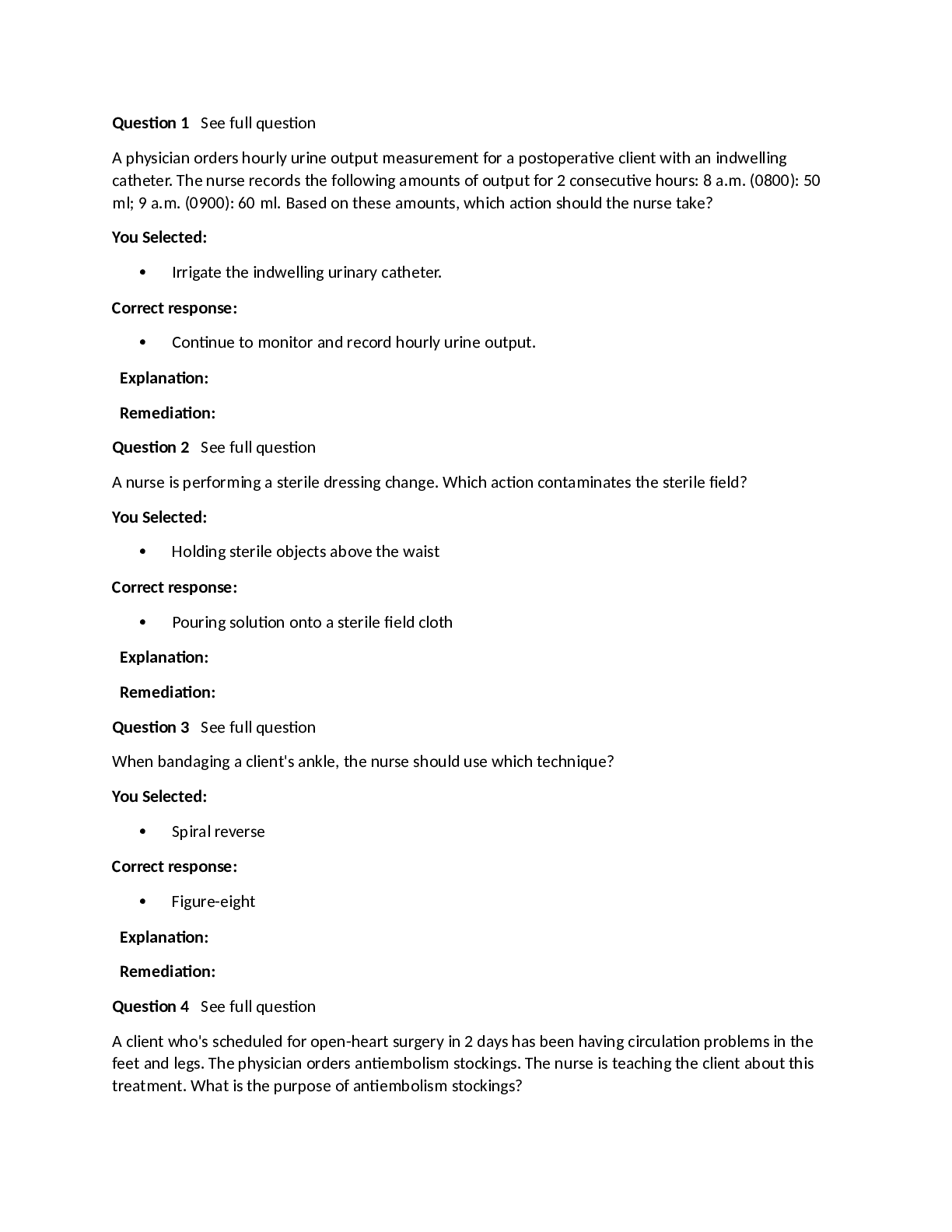
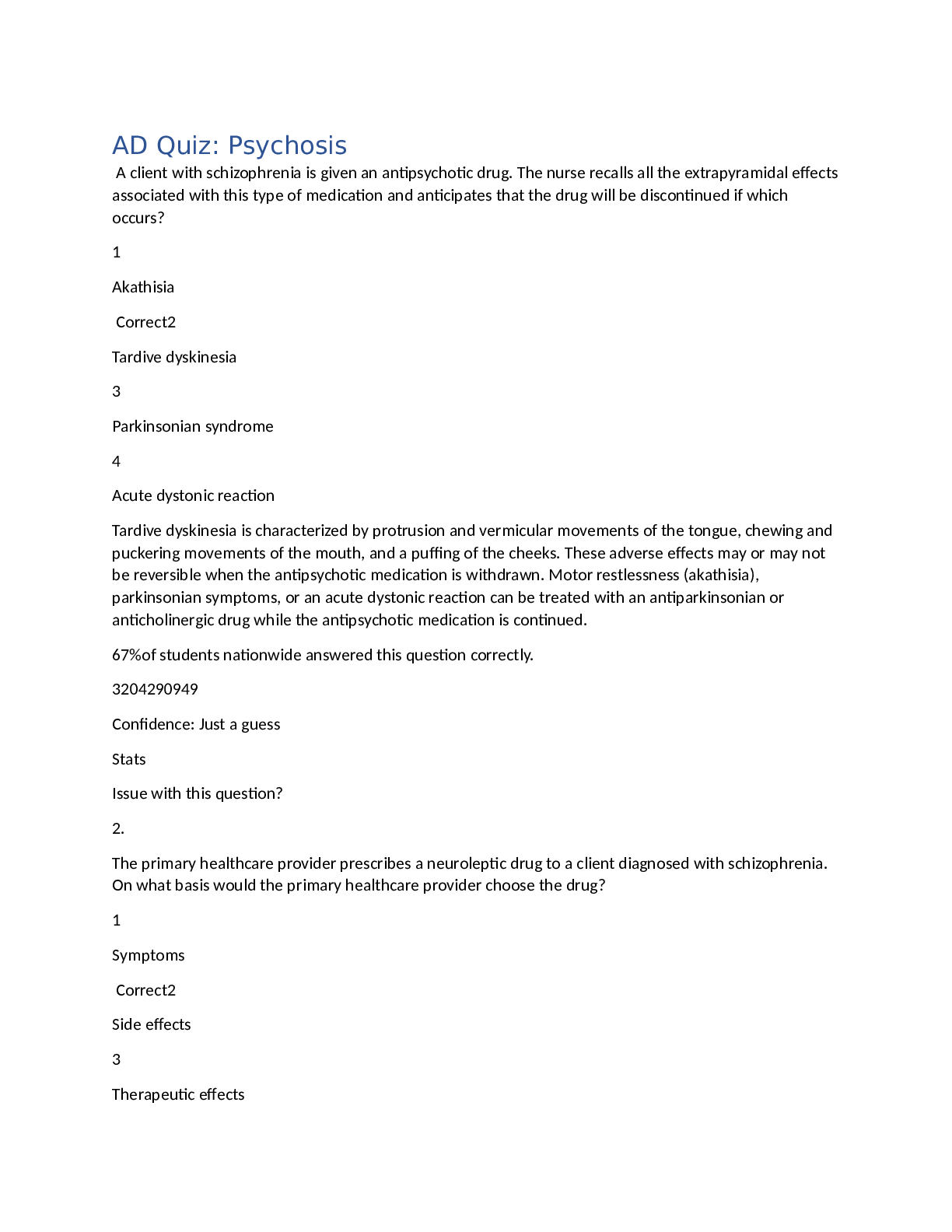

.png)



